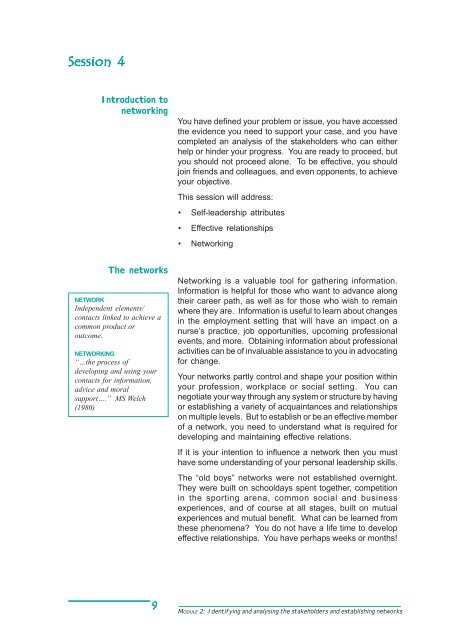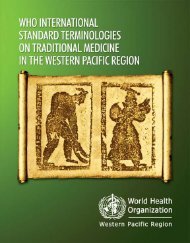MODULE 2: Identifying and analysing the stakeholders and ...
MODULE 2: Identifying and analysing the stakeholders and ...
MODULE 2: Identifying and analysing the stakeholders and ...
- No tags were found...
You also want an ePaper? Increase the reach of your titles
YUMPU automatically turns print PDFs into web optimized ePapers that Google loves.
Session 4Introduction tonetworkingYou have defined your problem or issue, you have accessed<strong>the</strong> evidence you need to support your case, <strong>and</strong> you havecompleted an analysis of <strong>the</strong> <strong>stakeholders</strong> who can ei<strong>the</strong>rhelp or hinder your progress. You are ready to proceed, butyou should not proceed alone. To be effective, you shouldjoin friends <strong>and</strong> colleagues, <strong>and</strong> even opponents, to achieveyour objective.This session will address:• Self-leadership attributes• Effective relationships• NetworkingThe networksNETWORKIndependent elements/contacts linked to achieve acommon product oroutcome.NETWORKING“…<strong>the</strong> process ofdeveloping <strong>and</strong> using yourcontacts for information,advice <strong>and</strong> moralsupport….” MS Welch(1980)Networking is a valuable tool for ga<strong>the</strong>ring information.Information is helpful for those who want to advance along<strong>the</strong>ir career path, as well as for those who wish to remainwhere <strong>the</strong>y are. Information is useful to learn about changesin <strong>the</strong> employment setting that will have an impact on anurse’s practice, job opportunities, upcoming professionalevents, <strong>and</strong> more. Obtaining information about professionalactivities can be of invaluable assistance to you in advocatingfor change.Your networks partly control <strong>and</strong> shape your position withinyour profession, workplace or social setting. You cannegotiate your way through any system or structure by havingor establishing a variety of acquaintances <strong>and</strong> relationshipson multiple levels. But to establish or be an effective memberof a network, you need to underst<strong>and</strong> what is required fordeveloping <strong>and</strong> maintaining effective relations.If it is your intention to influence a network <strong>the</strong>n you musthave some underst<strong>and</strong>ing of your personal leadership skills.The “old boys” networks were not established overnight.They were built on schooldays spent toge<strong>the</strong>r, competitionin <strong>the</strong> sporting arena, common social <strong>and</strong> businessexperiences, <strong>and</strong> of course at all stages, built on mutualexperiences <strong>and</strong> mutual benefit. What can be learned from<strong>the</strong>se phenomena? You do not have a life time to developeffective relationships. You have perhaps weeks or months!9<strong>MODULE</strong> 2: <strong>Identifying</strong> <strong>and</strong> <strong>analysing</strong> <strong>the</strong> <strong>stakeholders</strong> <strong>and</strong> establishing networks
















